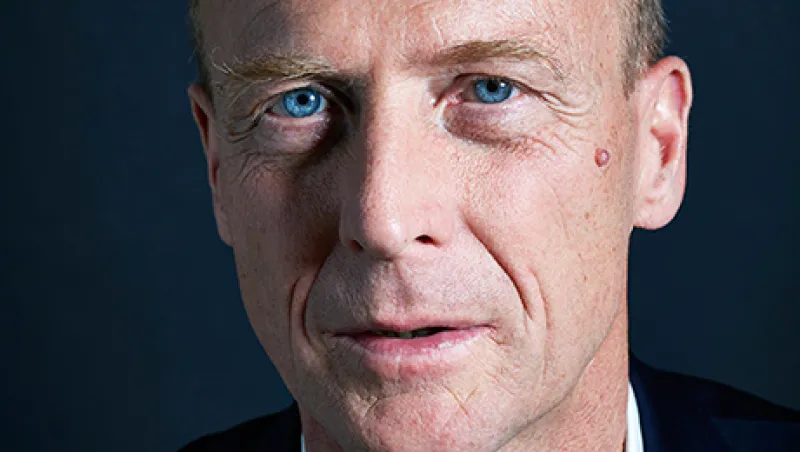When chief executive of France-based Airbus Group Thomas Enders was an exchange student at the University of California, Los Angeles, in the early 1980s, he spent his weekends in the desert, skydiving from old DC-3 Dakota airplanes. He couldn’t have guessed then that his taste for controlled-yet-adrenaline-heavy risk would one day lead him to steer a behemoth aerospace company into a new technological era, intent on finding opportunities for disruption.
At UCLA, German-born Enders studied economics, political science and history. He quickly warmed to what he considers an American philosophy about work that advocates shuffling through various jobs and even careers over the course of a lifetime. “You don’t get stuck on one path,” Enders says. After graduating in 1987 with a Ph.D. in political science from the University of Bonn, he embraced this mentality in his own career, working at a series of think tanks focused on international policy and military strategy, then moved to the planning task force of the German Ministry of Defense during the nation’s reunification. In 1991 he made the shift to industry, joining the marketing department of DaimlerChrysler Aerospace, then the aerospace subsidiary of Daimler-Benz. In 2000 he was promoted to head the defense and security systems business in the merger that created the European Aeronautic Defense and Space Company (EADS) — Airbus’s predecessor company. He has served as the group’s top leader since 2012.
“It was not preordained that I would become the CEO of a high-tech aerospace company,” says Enders, 57, who still occasionally skydives. “But life is exciting.”
Now Enders is in the midst of a new effort to bring that anything-is-possible air of excitement to his 136,000-employee company. He is launching new initiatives he hopes will encourage employees to open up to outside ideas, try new ways of doing things and embrace change. In mid-2015, Enders announced that the company would seed its first corporate venture capital arm, Airbus Group Ventures, with $150 million to invest in aerospace start-ups. In addition, it would establish a “disruption laboratory” in San Jose, California, called A³, where a team of Airbus engineers and new hires would be tasked with project-based efforts to rethink their industry. (Read more: Airbus Ventures Takes Off by Going Local)
Enders points out that trying to push for moon-shot innovations wasn’t working, mainly because Airbus was doing too well. Last year it took orders for more than 1,000 airplanes, nearly doubling the sales of Boeing Co., even as its Chicago-based rival delivered more jets than Airbus. The commercial aircraft division, which accounted for 70 percent of total group revenue of €65 billion ($73 billion) in 2015, boasts a record order backlog of nearly 7,000 aircraft. To keep up, Airbus has announced it is ramping up production of its A320 family of single-aisle planes to 60 a month by 2019, from about 54 today. Its first U.S. factory, which opened in Mobile, Alabama, in July 2015, will help toward that goal.
Institutional Investor Senior Contributing Writer Katie Gilbert sat down with Enders in March during the CEO’s first visit to the A³ office. Like the start-ups it’s emulating, the open-floorplan Airbus outpost includes a stocked kitchen with a refrigerator full of sodas and the quote “Don’t believe everything you think” written on a whiteboard wall. Its aerospace focus is also widely evident: Two rollable partition walls are fashioned from an old fuselage, complete with small airplane-passenger windows.
Before commencing the interview, Enders announced that he had to put on his new uniform. He shrugged off his suit jacket and replaced it with that Silicon Valley staple — a hoodie. Appropriately outfitted, the Airbus CEO discussed the challenge of strong sales and the areas of his industry that are ripest for disruption.
Institutional Investor: Why establish a Silicon Valley presence now?
Enders: Silicon Valley has developed in waves. You have the microchips, you have the computers, mobile phones, and now transportation is the recent wave — and the whole megatrend of digitalization. I saw that this would create enormous opportunities for the aerospace industry, which had, over the past couple of decades, not been as innovative as it was right after World War II.
In the ’50s and ’60s, aviation technology developed at an enormous speed. So from there people extrapolated that the trend would go much faster. Then you had the Gemini, the Apollo programs, trips to the moon. But somewhere in the ’70s and ’80s, that curve flattened.
Why did that happen?
Probably a multitude of reasons. America had won the race to the moon. I think the enthusiasm kind of cooled down. At the same time, you had the Vietnam War, which left some wounds on America. People discovered in the ’70s there was a lot to do back home, that money should be spent on social development rather than on moon shots.
And then, of course, companies discovered shareholder value, and that if you constantly invest in innovation, you don’t have earnings left for your shareholders. I think that has certainly played a role in the ’80s and ’90s.
If you look at the design of commercial aircraft, we still look like the ’60s. You have pretty much the same configuration. Yes, materials have changed, but ever since the first guys put jet engines in the commercial aircraft, the configuration is quite stable. It’s a proven configuration. There’s nothing wrong with it. But aerospace was the high-tech industry in the ’50s, ’60s and well into the ’70s. Then in the ’80s the personal computers and Internet came on.
I see a chance. With the enormous progress that we have made and are still making in terms of data generation, data exploitation and digitalization, this could also give a very significant boost to aerospace. And given that there are more and more companies in Silicon Valley that are focusing on transportation, autonomy, unmanned vehicles, space applications — think about Google, think about Facebook — I found it was the right time to bring a small but good group of people here to think stuff that we wouldn’t do in our normal organization.
What has the group at A³ been tasked to do?
Paul [Eremenko, CEO of A³ and formerly an executive in Google’s advanced projects organization] has the job of doing stuff that nobody wants to do because it’s too disruptive or too long-term, but revolutionary for aerospace. And that’s a wide field. These can be technologies, these can be systems, these can be processes.
He’s got the specific tasking from me to look after possibilities, threats, opportunities to disrupt the company. You can’t do that from within the company, which is pretty established, and it has to run. I mean, we are producing 600 to 700 large commercial aircraft a year. We’re producing 400 helicopters. We’re producing military planes and satellites. So we need a disciplined, functioning company. On the other hand, we also need some people who think ahead, who think without boundaries and limits.
This is really about the future of flight. Nothing less, nothing more. We’re a big aeronautics company, and we want to stay at the edge of progress and innovation. That requires different ways of doing things than we’ve had in the past.
What’s ripe for disruption?
Certainly, if we could considerably lower the nonrecurring development costs for future aircraft or spacecraft programs, we’d considerably shorten development times, and time is money. That could be disruptive. That sounds conventional. But the aerospace industry is notorious for not being able to complete projects on time and on budget.
The other thing is, Silicon Valley also stands for customer orientation. Can we get closer to our customers, to the end customers? Can we develop new business models, new services for our customers through digitalization, for instance, through better use of the tons of data we produce with our flying platforms? I think that’s a very interesting subject as well.
And then I think autonomy will play a huge role in the future. You see that with all the drone development and artificial intelligence. These are certainly things that the aerospace industry has to follow very keenly and hopefully be able to exploit for future products.
Is part of the desire to be in the Valley also coming from a new view of who your competitors are? You now see competitors in the likes of Google and SpaceX?
SpaceX definitely is a competitor. Google, I’m not sure, but it could well become one. Facebook could well become one. Amazon is entering the space race as well. Sure, being here means we’re closer to the competitors, we’re closer to the state-of-the-art development in technologies, in systems.
Speed is another important topic here. The speed with which people advance from idea to concept to demonstrator, prototype and product — or stop at any given stage because they find themselves at an impasse — is amazing compared to what the speed has been. We have multiple reasons to be here, to learn here, to be in close contact and engagement with a community of exciting companies and also start-ups.
You’ve announced a big ramp-up in airplane production through 2019. Is that going to be difficult to achieve?
Oh yes, it’s a big challenge for us but a big opportunity for the company. We have a huge demand in commercial aircraft. We have today a duopoly largely between our friends at Boeing and us. We have an enormous backlog. No one in the history of aviation had such an order backlog for aircraft: 6,800 aircraft and counting. And hence if we still want to sell aircraft — and if not, I should send the sales director and his people on a sabbatical — we need to ramp up production.
For three or four consecutive years now, we have sold more than 1,000 aircraft. And I’m only talking about large commercial aircraft per year. Whereas our production capacity is somewhere between 600 and 700 and increasing. Hence the ramp-up, the target being 60 single aisles a month in 2019. Is that a challenge? Absolutely. It’s a huge challenge for us; it’s a huge challenge for our supply chain. But we’ve met other huge challenges before. It can be done. I think if we come through this, 2015 and ’16 will be crucial years in that ramp-up. It’s a tremendous challenge but a good challenge to have.
Will the Silicon Valley outpost help drive your internationalization strategy?
Setting up shop here in Silicon Valley is one — not the only, but one — important element for Airbus’s international innovation strategy. I’m sure we can benefit a lot from the networking environment, the innovative environment over here and create a kind of iterative process between the mother ship and the activities over here. I think there’s a lot to do, a lot to learn.
I see already my company being reenergized as far as innovative spirit. I set this up here also as a deliberate provocation to the mother ship, in the sense that I know we have thousands of brilliant people in the company, young people in the company, who are just as innovative as people over here. And it worked as a challenge. Many people have responded: “Does Tom think that Silicon Valley is the only place where innovation can happen? We will demonstrate to him that he is wrong.”
We’ll see where this gets us. The sky’s not the limit. •
Read more on corporations.






